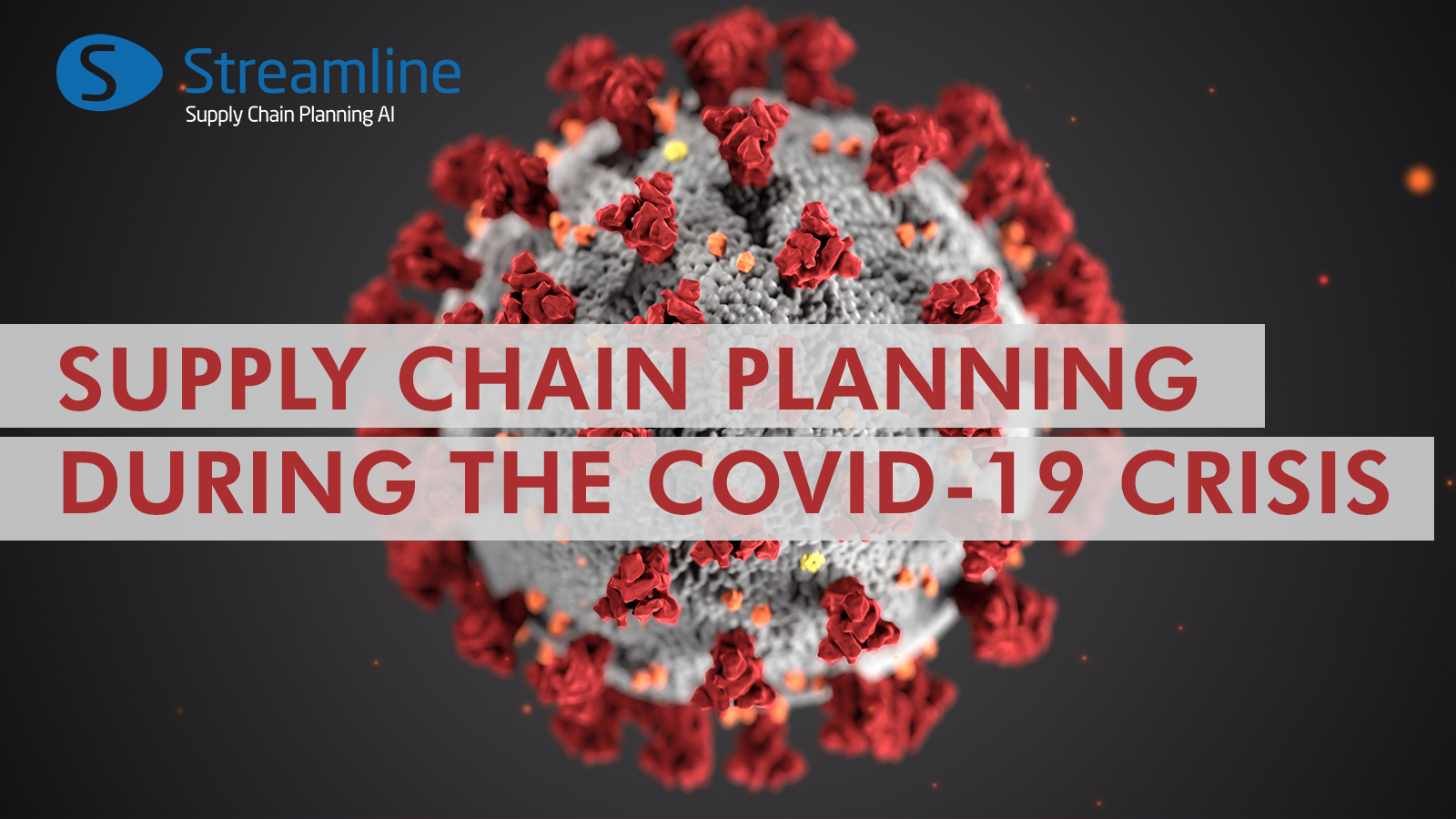Como lidar com os processos da cadeia de suprimentos durante o surto de Coronavírus
-

Índice:
- 1. Gerenciamento do estoque de segurança
- 2. Otimização de estoque por meio de transferências entre lojas
- 3. Anulação da previsão
- 4. Planejamento Integrado da Demanda e do Inventário
Eventos que mudam o mundo estão acontecendo de forma imprevisível e influenciando todas as partes de nossa vida e negócios. A pandemia tem um impacto na desaceleração do crescimento econômico no momento. Para muitas empresas em todo o mundo, a consideração mais importante das primeiras doze semanas do surto da COVID-19 tem sido o efeito sobre as cadeias de abastecimento não só que começam ou passam pela China, mas também locais.
Além de enfrentar as flutuações da demanda dos consumidores, as empresas precisam navegar pelos desafios da cadeia de suprimentos. Atualmente, vemos que as empresas com equipes de compras centralizadas e boas relações com os fornecedores estão se sentindo mais confiantes quanto ao seu entendimento dos riscos que esses fornecedores enfrentam. Outros ainda estão lutando com sua exposição na China e em outros complexos de transmissão. A COVID-19 também está servindo como um acelerador para que as empresas façam mudanças estratégicas e de longo prazo nas cadeias de abastecimento—changes que muitas vezes já estavam sendo considerados (McKinsey & Company(março de 2020). Nesta situação, as empresas estão procurando uma solução para ajudá-las na otimização do processo de gestão da cadeia de abastecimento. GMDH Streamline integra análise de estoque, previsão de demanda, planejamento de estoque e funções de reabastecimento em uma única aplicação e melhora o processo de planejamento da cadeia de abastecimento em todas as etapas.
Em nossa experiência, há 4 as ferramentas mais úteis do Streamline que podem ajudar os atacadistas, fabricantes e varejistas de todos os tamanhos. Nós os descrevemos aqui como uma ajuda aos líderes que passam pela gestão de crises para suas empresas nos dias de hoje.
1. Gerenciamento do estoque de segurança
Talvez a maior incerteza para os gerentes da cadeia de suprimentos e chefes de produção seja a demanda dos clientes e ter um nível ótimo de estoque de segurança é de importância crucial para ambos - empresas que se mantiveram na falta de demanda, ou que lutam com um pico imprevisível da mesma. Durante o período regular, geralmente sugerimos processos automatizados da cadeia de fornecimento com ajustes manuais apenas em situações imprevisíveis. O momento atual, no entanto, é um dos raros casos em que a nossa recomendação de melhores práticas é a de consultar seus especialistas em demanda para orientar o software em direção a decisões comerciais ideais antes, durante e após o aumento da demanda. Não há nenhum sistema, por mais avançado que seja, que seja capaz de automatizar com precisão os cálculos quando não há nenhum caso histórico sobre o qual basear o modelo de previsão. Com base nos modelos de previsão em mudança de seus planejadores para a aplicação das regras comerciais, o Streamline pode atualizar os limites de estoque de segurança e fazer com que você faça o pedido futuro ideal.
2. Otimização de estoque por meio de transferências entre lojas
O Streamline é capaz de otimizar seu estoque liberando internamente o capital congelado e reabastecer seus locais usando seus próprios estoques excedentes em vez de fazer mais pedidos de reabastecimento de seus fornecedores ou centros de distribuição. Se seu negócio estiver espalhado por várias regiões separadas de modo que cada uma delas contenha um conjunto de locais onde as transferências de estoque são permitidas, o Streamline pode contabilizar essas restrições e gerar transferências dentro das áreas determinadas. Assim, você poderá reagir a picos de demanda em diferentes áreas usando seu estoque atual enquanto espera pela próxima entrega do pedido.
Um dos clientes do Streamline é o principal varejista de nutrição esportiva do Canadá que utiliza a otimização entre lojas durante a quarentena que fechou muitas lojas. A melhor maneira de reagir rapidamente nesta situação é fazer transferências de grandes quantidades de estoque de lojas fechadas para lojas em funcionamento.
3. Anulação da previsão
As anulações de previsão direta são tipicamente usadas quando se planeja uma grande promoção ou uma ampla venda de liberação, ou qualquer outro evento que não esteja representado no histórico de vendas. Um Streamline varejista de canetas promocionais de alta qualidade com sede nos EUA marcou o surto do Coronavirus como um evento, portanto não influencia as previsões futuras. Ainda assim, o Streamline terá esta informação que será útil durante os próximos eventos imprevisíveis. Em seguida, para recalcular a queda nas vendas comerciais devido à COVID-19, é recomendado anular manualmente as previsões ou aplicar os coeficientes decrescentes para os próximos meses. Nenhuma das aplicações pode prever a queda nas vendas devido a uma força maior, portanto, aqui no Streamline, criamos a oportunidade para os usuários adicionarem seus conhecimentos à previsão estatística e, como resultado, obterem previsões baseadas em seus conhecimentos profissionais, percepções do setor e experiência.
4. Planejamento Integrado da Demanda e do Inventário
Previsão de demanda, planejamento e reposição de estoque, análise ABC, Relatório KPIs, Painel KPIs são funções todas configuradas em um único lugar, o que facilita muito o processo e reduz muito o trabalho manual. O resultado surgirá antes da possibilidade dos planejadores se concentrarem na busca do caminho para a melhor decisão comercial e gerenciar o ciclo de vida deste evento com a escolha do momento certo para retornar à previsão de base. Quando os planejadores tiverem ferramentas à sua disposição para ajudá-los a tomar as decisões corretas da maneira mais rápida e eficiente possível, sua empresa cruzará este surto com mais confiança.
Streamline - uma solução simples de planejamento de demanda e inventário para responder ao surto de coronavírus. Somente aquelas empresas sobrevivem que aprenderão a administrar adequadamente seus recursos. Portanto, este é o lugar certo e o momento certo para as empresas que utilizam o Streamline obterem o máximo de seus recursos.
Ainda depende do trabalho manual no Excel para o planejamento?
Automatize o planejamento da demanda e do fornecimento com o Streamline hoje mesmo!
- Obtenha disponibilidade ideal de estoque 95-99%+, garantindo que você possa atender à demanda do cliente de forma consistente.
- Obtenha precisão de previsão de até 99%, obtendo planejamento e tomada de decisões mais confiáveis.
- Experimente uma redução de até 98% nas rupturas de estoque, minimizando oportunidades de vendas perdidas e a insatisfação do cliente.
- Reduza o excesso de estoque em até 50%, liberando capital valioso e espaço de armazenamento.
- Aumente as margens em 1 a 5 pontos percentuais, aumentando a lucratividade geral.
- Desfrute de um ROI de até 56 vezes em um ano, com um ROI de 100% alcançável nos primeiros três meses.
- Reduza o tempo gasto em previsões, planejamento e pedidos em até 90%, permitindo que sua equipe se concentre em atividades estratégicas.
